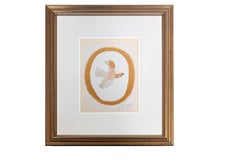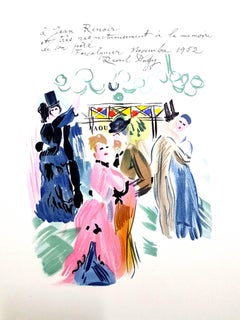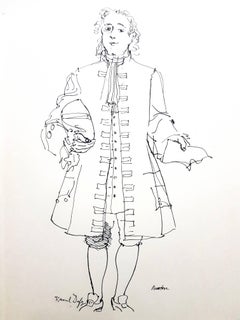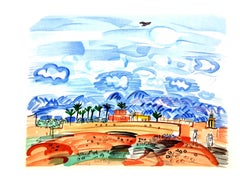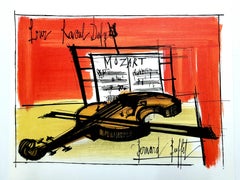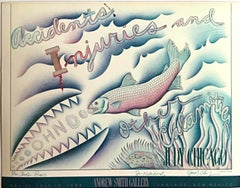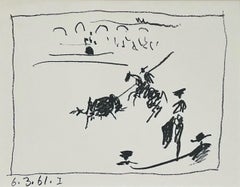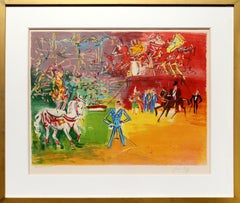Fauvist Animal Prints
to
1
14
5
1
Overall Width
to
Overall Height
to
1,975
1,383
407
285
222
153
120
80
39
39
33
12
12
4
8
1
1
1
1
20
17
1
1
1
13
6
13
9
6
5
5
4
3
2
1
1
1
1
1
1
1
1
1
1
1
1
18
2
1
1
1
1
1
17
3
Style: Fauvist
"L'oiseau de sables (Bird of the Sands)" contemporary animal bright signed
Located in Milwaukee, WI
"L'oiseau de sables" ("Bird of the Sands") is an original signed lithograph by Georges Braque executed in 1962. It is 37 of an edition of 125. The work is one of five lithographs cre...
Category
1960s Fauvist Animal Prints
Materials
Printer's Ink, Lithograph
L'Aquarium
Located in New York, NY
A very good impression of this color aquatint. Signed and numbered 2/100 in red crayon, lower margin. Published by Maeght, Paris.
Category
1950s Fauvist Animal Prints
Materials
Color, Aquatint
Homage to Renoir - Lithograph
Located in Collonge Bellerive, Geneve, CH
(after) Raoul Dufy
Lithograph after a watercolor, published in the book "Lettre à mon peintre Raoul Dufy." Paris, Librairie Académique Perrin, 1965.
Printed signature
Dimensions: ...
Category
1940s Fauvist Animal Prints
Materials
Lithograph
Raoul Dufy (after) - Lithograph
Located in Collonge Bellerive, Geneve, CH
(after) Raoul Dufy
Lithograph after a watercolor, published in the book "Lettre à mon peintre Raoul Dufy." Paris, Librairie Académique Perrin, 1965.
Printed signature
Di...
Category
1940s Fauvist Animal Prints
Materials
Lithograph
Raoul Dufy (after) - Landscape - Lithograph
By Raoul Dufy
Located in Collonge Bellerive, Geneve, CH
(after) Raoul Dufy
Lithograph after a watercolor, published in the book "Lettre à mon peintre Raoul Dufy." Paris, Librairie Académique Perrin, 1965.
Printed signature
Dimensions: ...
Category
1940s Fauvist Animal Prints
Materials
Lithograph
Bernard Buffet - Homage to Dufy - Lithograph
Located in Collonge Bellerive, Geneve, CH
(after) Bernard Buffet
Lithograph after a watercolor, published in the book "Lettre à mon peintre Raoul Dufy." Paris, Librairie Académique Perrin, 1965.
Printed signature
Dimension...
Category
1940s Fauvist Animal Prints
Materials
Lithograph
Jacques Villon (after) - Homage to Dufy - Lithograph
Located in Collonge Bellerive, Geneve, CH
(after) Jacques Villon
Lithograph after a watercolor, published in the book "Lettre à mon peintre Raoul Dufy." Paris, Librairie Académique Perrin, 1965.
Printed signature...
Category
1940s Fauvist Animal Prints
Materials
Lithograph
A Cat's Eyes - Transfer Monotype in Water Based Ink on Paper
Located in Soquel, CA
A Cat's Eyes - Transfer Monotype in Water Based Ink on Paper
Original transfer monotype painting by California artist Heather Speck (American, 20th C). Boldly colored close up of a ...
Category
1990s Fauvist Animal Prints
Materials
Paper, Ink, Monotype
$480 Sale Price
20% Off
Raoul Dufy (after) - Autoportrait - Lithograph
By Raoul Dufy
Located in Collonge Bellerive, Geneve, CH
(after) Raoul Dufy
Lithograph after a watercolor, published in the book "Lettre à mon peintre Raoul Dufy." Paris, Librairie Académique Perrin, 1965.
Printed signature
Dimensions: ...
Category
1940s Fauvist Animal Prints
Materials
Lithograph
Charles Lapicque (after) - Homage to Dufy - Lithograph
Located in Collonge Bellerive, Geneve, CH
(after) Charles Lapicque
Lithograph after a watercolor, published in the book "Lettre à mon peintre Raoul Dufy." Paris, Librairie Académique Perrin, 1965.
Printed signatu...
Category
1940s Fauvist Animal Prints
Materials
Lithograph
After Raoul Dufy - Birds - Lithograph
Located in Collonge Bellerive, Geneve, CH
(after) Raoul Dufy
Lithograph after a watercolor, published in the book "Lettre à mon peintre Raoul Dufy." Paris, Librairie Académique Perrin, 1965.
Printed signature
Di...
Category
1940s Fauvist Animal Prints
Materials
Lithograph
Modernity - Lithograph - After Raoul Dufy
Located in Collonge Bellerive, Geneve, CH
(after) Raoul Dufy
Lithograph after a watercolor, published in the book "Lettre à mon peintre Raoul Dufy." Paris, Librairie Académique Perrin, 1965.
Printed signature
Dimensions: ...
Category
1940s Fauvist Animal Prints
Materials
Lithograph
Composition - Lithograph
Located in Collonge Bellerive, Geneve, CH
(after) Raoul Dufy
Lithograph after a watercolor, published in the book "Lettre à mon peintre Raoul Dufy." Paris, Librairie Académique Perrin, 1965.
Printed signature
Di...
Category
1940s Fauvist Animal Prints
Materials
Lithograph
André Marchand (after) - Homage to Dufy - Lithograph
Located in Collonge Bellerive, Geneve, CH
(after) André Marchand
Lithograph after a watercolor, published in the book "Lettre à mon peintre Raoul Dufy." Paris, Librairie Académique P...
Category
1940s Fauvist Animal Prints
Materials
Lithograph
Raoul Dufy (after) - Autoportrait - Lithograph
By Raoul Dufy
Located in Collonge Bellerive, Geneve, CH
(after) Raoul Dufy
Lithograph after a watercolor, published in the book "Lettre à mon peintre Raoul Dufy." Paris, Librairie Académique Perrin, 1965.
Printed signature
Dimensions: ...
Category
1940s Fauvist Animal Prints
Materials
Lithograph
Marcel Gromaire (after) - Homage to Dufy - Lithograph
Located in Collonge Bellerive, Geneve, CH
(after) Marcel Gromaire
Lithograph after a watercolor, published in the book "Lettre à mon peintre Raoul Dufy." Paris, Librairie Académique Perrin, 1965.
Printed signatur...
Category
1940s Fauvist Animal Prints
Materials
Lithograph
Still Life - Lithograph
Located in Collonge Bellerive, Geneve, CH
(after) Raoul Dufy
Lithograph after a watercolor, published in the book "Lettre à mon peintre Raoul Dufy." Paris, Librairie Académique Perrin, 1965.
Printed signature
Di...
Category
1940s Fauvist Animal Prints
Materials
Lithograph
Concert - Lithograph
Located in Collonge Bellerive, Geneve, CH
(after) Raoul Dufy
Lithograph after a watercolor, published in the book "Lettre à mon peintre Raoul Dufy." Paris, Librairie Académique Perrin, 1965.
Printed signature
Di...
Category
1940s Fauvist Animal Prints
Materials
Lithograph
Jean Lurçat (after) - Homage to Dufy - Lithograph
By Jean Lurçat
Located in Collonge Bellerive, Geneve, CH
(after) Jean Lurçat
Lithograph after a watercolor, published in the book "Lettre à mon peintre Raoul Dufy." Paris, Librairie Académique Perrin, 1965.
Printed signature
Dimensions: ...
Category
1940s Fauvist Animal Prints
Materials
Lithograph
Autoportrait - Lithograph
Located in Collonge Bellerive, Geneve, CH
(after) Raoul Dufy
Lithograph after a watercolor, published in the book "Lettre à mon peintre Raoul Dufy." Paris, Librairie Académique Perrin, 1965.
Printed signature
Di...
Category
1940s Fauvist Animal Prints
Materials
Lithograph
Related Items
Judy Chicago poster (Hand signed and inscribed) feminist art
By Judy Chicago
Located in New York, NY
Accidents, Injuries and other Calamities poster
Judy Chicago (Hand signed and inscribed), 1988
Offset lithograph on thin board (signed and inscribed by Judy Chicago)
26 × 20 1/4 inch...
Category
1980s Fauvist Animal Prints
Materials
Lithograph, Offset, Pencil
$900
H 26 in W 20.25 in
La Pique (I), from A Los Toros Avec Picasso
Located in Washington, DC
Artist: Pablo Picasso
Title: La Pique (I)
Portfolio: A Los Toros Avec Picasso
Medium: Transfer lithograph
Date: 1961
Frame Size: 17 1/4" x 19 3/4"
Sheet Size: 9 1/2" x 12 1/2"
Image ...
Category
1960s Fauvist Animal Prints
Materials
Lithograph
Western Pals
By Red Grooms
Located in Lyons, CO
Color lithograph, Edition 40.
Red Grooms is a painter, sculptor, printmaker, filmmaker, and showman par excellence. His major installations, “Ruckus Manhattan”, “The City of Chicago...
Category
1990s Fauvist Animal Prints
Materials
Lithograph
Turtle - Original Lithograph by Carlo Quattrucci - 1971
Located in Roma, IT
Turtle is an original artwork realized by Carlo Quattrucci in 1971.
Hand Signed and dated on the lower right margin.
Numbered on the lower left. Edition of 70 pieces plus some Arti...
Category
1970s Fauvist Animal Prints
Materials
Lithograph
$252 Sale Price
25% Off
H 19.69 in W 25.6 in D 0.08 in
CIGAR Champion Horse Portrait Signed Lithograph Equine Art, Horse Racing History
Located in Union City, NJ
CIGAR - Champion Horse Portrait 1997 by the contemporary woman artist and distinguished realist painter Jenness Cortez, is an original hand drawn limited edition lithograph printed using hand lithography techniques on archival paper 100% acid free. CIGAR is a lifelike, realistic equine portrait depicting the superstar thoroughbred racehorse Cigar, who was two-time Horse of the Year winner, a member of the National Racing Hall of Fame, and arguably the greatest racehorse of the 1990s. CIGAR, a visually impressive handmade lithograph, displays an appealing neutral color palette in shades of warm copper brown, grays, and charcoal black on a light slate blue background.
Print size - 29.5" x 25", unframed, excellent condition, pencil signed by Jenness Cortez
Image Size - 26" x 21"
Edition size - 250, plus proofs
Year - 1997
Printer - JK Fine Art Editions Co., NJ
High quality hand drawn lithograph, classic equine portrait, sporting art print pencil signed by Ms. Cortez on lower margin, First-rate hand crafted print, not a commercially mass photo reproduced poster or digital reproduction.
ABOUT THE ARTIST:
Jenness Cortez is a mid-career artist with astonishing talent. Born 1944 in Indiana, Jenness Cortez began her formal art studies at the age of sixteen under the guidance of noted Dutch painter, Antonius Raemaekers...
Category
1990s Fauvist Animal Prints
Materials
Lithograph
Jenness CortezCIGAR Champion Horse Portrait Signed Lithograph Equine Art, Horse Racing History, 1997
$472 Sale Price
30% Off
H 29.5 in W 25 in
"Jabberwocky" Poem by Lewis Carrol with Engravings, Designed by Nick Zachreson
Located in Soquel, CA
"Jabberwocky" Poem by Lewis Carrol with Engravings, Designed by Nick Zachreson
Elegant print of Lewis Carrol's poem "Jabberwocky" with illustrations, designed and printed by Nick Za...
Category
1990s Fauvist Animal Prints
Materials
Ink, Laid Paper
$700
H 28 in W 16 in D 0.25 in
Les Banderilles (IV), from A Los Toros Avec Picasso
Located in Washington, DC
Artist: Pablo Picasso
Title: Les Banderilles (IV)
Portfolio: A Los Toros Avec Picasso
Medium: Transfer lithograph
Date: 1961
Edition: Unnumbered
Frame Size: 18 1/4" x 20 3/4"
Sheet ...
Category
1960s Fauvist Animal Prints
Materials
Lithograph
Lait Pur de la Vingeanne Stérilisé, Young Girl, Cats, Vintage French Advertising
Located in Union City, NJ
Lait Pur de la Vingeanne Stérilisé is an offset lithographic print reproduced after the original 1894-95 Belle Epoque advertising poster created by Théophile Steinlen, printed using 4-color offset lithography on heavyweight archival paper. Lait Pur de la Vingeanne Stérilisé depicts a seated rosy cheeked young girl (the artist's daughter) wearing a long red dress sipping milk from a bowl as a group of envious animal friends - 3 cats...
Category
1980s Fauvist Animal Prints
Materials
Lithograph
$200 Sale Price
20% Off
H 35.25 in W 26 in
Two Hand Coloured 18th Century Engravings from "Small Riding School" No 26 & 32
Located in Cotignac, FR
Two Mid 18th century hand coloured copper plate engravings of equestrian subjects by Johann Elias Ridinger. Initial signed 'in the plate' bottom right. Presented in fine gilt wood fr...
Category
Mid-18th Century Fauvist Animal Prints
Materials
Watercolor, Ink
$601
H 12.6 in W 10.24 in D 0.6 in
Pierre Bonnard Lithograph Printed at Mourlot Paris 1958 Mosque Minaret, Swan
Located in Surfside, FL
This is from a limited edition portfolio of original lithographs print Fernand Mourlot in Paris in 1958 from work done in collaboration with Bonnard which began in 1928.
A mosque ...
Category
20th Century Fauvist Animal Prints
Materials
Lithograph
THE BANNISTER
By Will Barnet
Located in Aventura, FL
Lithograph on arches paper. Hand signed, dated titled and numbered in pencil by the artist. From the deluxe edition of 125. Image size 32 x 25 inches. Sheet size 36 x 26.5 inches. ...
Category
1980s Fauvist Animal Prints
Materials
Paper, Lithograph
Expresses Nothing but the Self
Located in Lyons, CO
Color lithograph, Ed. 30
Chagoya's newest prints, "Invites Into the World of the Eternal Instant" and "Expresses Nothing but the Self", are concerned with the current unsustainabl...
Category
21st Century and Contemporary Fauvist Animal Prints
Materials
Lithograph
Previously Available Items
Sacrifices Made to the Nymphs, from Daphnis and Chloe
By Marc Chagall
Located in Washington, DC
Artist: Marc Chagall
Medium: Color lithograph
Title: Sacrifices Made to the Nymphs, from Daphnis and Chloe
Portfolio: Daphnis and Chloe
Year: 1961
Edition: 32/60 from deluxe edition ...
Category
1960s Fauvist Animal Prints
Materials
Lithograph
Creation
By Marc Chagall
Located in Washington, DC
Marc Chagall Creation
Artist: Marc Chagall
Medium: Original lithograph
Title: Creation
Portfolio: Drawings for the Bible
From VERVE, Vol. X, Nos. 37 a...
Category
1960s Fauvist Animal Prints
Materials
Lithograph
Birds - Vintage Offset Print after Georges Braque - 1970s
Located in Roma, IT
Birds is a vintage offset poster realized in 1970s after a work by Georges Braque.
Not signed, limited edition of 1.000.
Good condition except for some folding on margins.
Category
1970s Fauvist Animal Prints
Materials
Offset
Raoul Dufy (after) - Autoportrait - Lithograph
By Raoul Dufy
Located in Collonge Bellerive, Geneve, CH
(after) Raoul Dufy
Lithograph after a watercolor, published in the book "Lettre à mon peintre Raoul Dufy." Paris, Librairie Académique Perrin, 1965.
Printed signature
Dimensions: ...
Category
1940s Fauvist Animal Prints
Materials
Lithograph
Boats - Lithograph
Located in Collonge Bellerive, Geneve, CH
(after) Raoul Dufy
Lithograph after a watercolor, published in the book "Lettre à mon peintre Raoul Dufy." Paris, Librairie Académique Perrin, 1965.
Printed signature
Di...
Category
1940s Fauvist Animal Prints
Materials
Lithograph
Modernity - Lithograph
Located in Collonge Bellerive, Geneve, CH
(after) Raoul Dufy
Lithograph after a watercolor, published in the book "Lettre à mon peintre Raoul Dufy." Paris, Librairie Académique Perrin, 1965.
Printed signature
Dimensions: ...
Category
1940s Fauvist Animal Prints
Materials
Lithograph
Bernard Buffet (after) - Homage to Dufy - Lithograph
Located in Collonge Bellerive, Geneve, CH
(after) Bernard Buffet
Lithograph after a watercolor, published in the book "Lettre à mon peintre Raoul Dufy." Paris, Librairie Académique Perrin, 1965.
Printed signature
Dimension...
Category
1940s Fauvist Animal Prints
Materials
Lithograph
H 11.82 in W 9.45 in D 0.04 in
Circus Equestrienne Harlequin
Located in Surfside, FL
This is an original hand signed (I believe it is also hand colored but i am not positive) Artists Proof Lithograph of a Circus scene. This depicts a circus equestrienne Harlequin
This came from a portfolio inscribed by Vertes and also signed by the Surrealist Jean Cocteau.
MARCEL VERTES FRENCH HUNGARIAN 1895(Ujpest, Hungary)-1961(Paris, France) art deco artist.Vertes was born in Hungary and died in Paris, but spent a lot of time in New York as well. He was noted as a painter, illustrator, designer and scenic mural...
Category
1940s Fauvist Animal Prints
Circus Equestrienne with Horses
Located in Surfside, FL
This is an original hand signed (I believe it is also hand colored but i am not positive) Artists Proof Lithograph of a Circus scene. This depicts a trapeze artist an acrobat on the high wire.
This came from a portfolio inscribed by Vertes and also signed by the Surrealist Jean Cocteau.
MARCEL VERTES FRENCH HUNGARIAN 1895(Ujpest, Hungary)-1961(Paris, France) art deco artist.Vertes was born in Hungary and died in Paris, but spent a lot of time in New York as well. He was noted as a painter, illustrator, designer and scenic mural...
Category
1940s Fauvist Animal Prints
Fauvist animal prints for sale on 1stDibs.
Find a wide variety of authentic Fauvist animal prints available for sale on 1stDibs. Works in this style were very popular during the 20th Century, but contemporary artists have continued to produce works inspired by this movement. If you’re looking to add animal prints created in this style to introduce contrast in an otherwise neutral space in your home, the works available on 1stDibs include elements of orange, pink, purple and other colors. Many Pop art paintings were created by popular artists on 1stDibs, including (after) Raoul Dufy, André Marchand, (after) Georges Braque, and Georges Braque. Frequently made by artists working with Lithograph, and Aquatint and other materials, all of these pieces for sale are unique and have attracted attention over the years. Not every interior allows for large Fauvist animal prints, so small editions measuring 9.45 inches across are also available. Prices for animal prints made by famous or emerging artists can differ depending on medium, time period and other attributes. On 1stDibs, the price for these items starts at $756 and tops out at $26,100, while the average work sells for $1,297.
